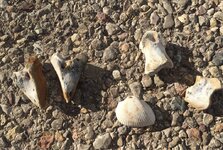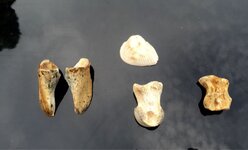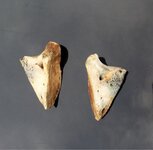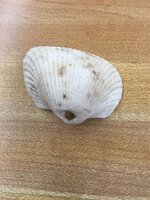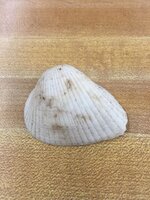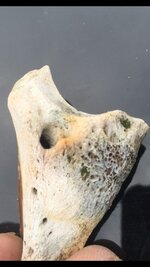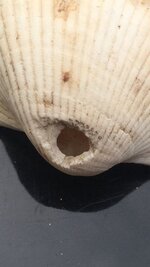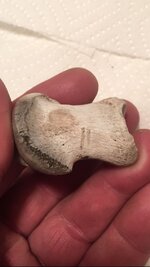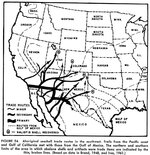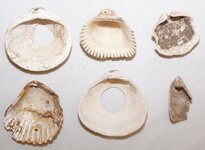Navigation
Install the app
How to install the app on iOS
Follow along with the video below to see how to install our site as a web app on your home screen.
Note: This feature may not be available in some browsers.
More options
You are using an out of date browser. It may not display this or other websites correctly.
You should upgrade or use an alternative browser.
You should upgrade or use an alternative browser.
Native American jewelry / trade items?
- Thread starter mn9000
- Start date
The Grim Reaper
Gold Member
I have found hundreds of those type of Bones, deer toes, and have only seen one that was drilled and used as a Bead or Pendant. Those look unaltered so most likely part of a left over meal washing out. You may find Points or Tools nearby though.
mn9000
Full Member
- Oct 10, 2016
- 199
- 248
- Primary Interest:
- All Treasure Hunting
- Thread starter
- #4
I have found hundreds of those type of Bones, deer toes, and have only seen one that was drilled and used as a Bead or Pendant. Those look unaltered so most likely part of a left over meal washing out. You may find Points or Tools nearby though.
What about the hole in that seashell Grim? Think it might have been a pendant possibly?
georgia flatlander
Full Member
The hole in the seashell looks man-made. The natural holes in seashells are usually a perfect drill hole from a rival crustacean, such as a horse conch, with no breakage around the hole. It's difficult to say what made it, but the shell is a typical and common type of salt water cockle shell. Since New Mexico doesn't have a coast, the shell was obviously imported. It doesn't have the look of extremely old shells, where most of the patina has worn away, nor the polished perfection of a shell that has tumbled for years in the ocean. The edges of the hole are ragged and broken, which suggests drilling or puncturing.
I have found many gorget-type shells that were obviously drilled, and plenty of others in which the holes were completely smooth. The bottom line is that it's hard to tell, but the location being far from the ocean makes me suspect that it could be man made.
I have found many gorget-type shells that were obviously drilled, and plenty of others in which the holes were completely smooth. The bottom line is that it's hard to tell, but the location being far from the ocean makes me suspect that it could be man made.
Jon Stewart
Bronze Member
- Jan 11, 2011
- 1,029
- 934
New Mexico used to have a coast. I have found a jar full of crinoids in New Mexico and a few sea shells.
Good finds.
Good finds.
Charl
Silver Member
New Mexico used to have a coast. I have found a jar full of crinoids in New Mexico and a few sea shells.
Good finds.
It was under a sea, but millions of years ago, so maybe the shell is a fossil. Should be easy to tell, since it will have "turned to stone" if it's fossilized. If it's still shell, it could be something the natives there strung, and obtained via trade...
- May 9, 2012
- 23,962
- 81,290
- Primary Interest:
- Other
Well preserved toe bones. Must be real dry where they been. A year or two here they would be history/ gone.
The outer coverings ( missing on your examples , why is subject to deterioration rate compared to bone perhaps) of them are more like cow horn ,or our fingernails. Boiling the toes a bit, then compressing them is one way to remove the outer part that could then be cleaned a little more and then dried for rattles or other decor.
The cut marks you ask about butchering are midspan of a bone.
Working around the joint is easier to separate. Easier on the tool also. Little flesh there so low odds ( not impossible) of cutting at a right angle there.
The outer coverings ( missing on your examples , why is subject to deterioration rate compared to bone perhaps) of them are more like cow horn ,or our fingernails. Boiling the toes a bit, then compressing them is one way to remove the outer part that could then be cleaned a little more and then dried for rattles or other decor.
The cut marks you ask about butchering are midspan of a bone.
Working around the joint is easier to separate. Easier on the tool also. Little flesh there so low odds ( not impossible) of cutting at a right angle there.
Charl
Silver Member
mn9000
Full Member
- Oct 10, 2016
- 199
- 248
- Primary Interest:
- All Treasure Hunting
- Thread starter
- #11
Thanks Charl, good information . I appreciate it. We target shoot on a friends cattle ranch about 50 miles outside Ruidoso. When I showed him what we found on his land he asked us to come back out as soon as we could with a sifter & our metal detectors. I'm really looking forward to getting back out there & digging around a little bit. Hopefully I'll have more pictures to post this weekend
Old Pueblo
Bronze Member
Nice find. Thats definitely a man made hole. And considering where you found it, it probably came from the Gulf of California like mine did. Im not 100%, but I believe Ruidoso is in Mogollon cultural area, which is right to east of the Hohokam area, so it may have been traded from the Hohokam to the Mogollon.
Old Pueblo
Bronze Member
Here are some Hohokam(Arizona) shell pendants. Notice the smaller holes are at the hinge end of the shell, similar to your shell....
View attachment 1476389
Where did you find these? Are these your personal finds, or something you found online?
Old Pueblo
Bronze Member
Nice find on the map. Ill be saving this one.
welsbury
Bronze Member
The shell looks like it was used for something possibly a necklace. And yours may be random bones but Great Basin people used hoofs of deer for necklaces and rattles.
Last edited:
Top Member Reactions
-
 3553
3553 -
 2067
2067 -
 2059
2059 -
 1177
1177 -
 1105
1105 -
 926
926 -
 850
850 -
 825
825 -
 812
812 -
 780
780 -
 770
770 -
 551
551 -
 531
531 -
 456
456 -
 451
451 -
 449
449 -
E
423
-
 414
414 -
 408
408 -
 407
407
Users who are viewing this thread
Total: 2 (members: 0, guests: 2)
